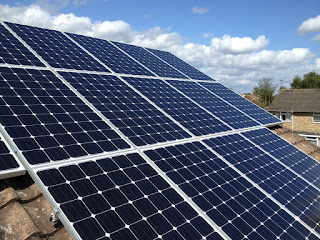Bacteria-Powered Solar Cells
Solar Energy Even on Cloudy Days
Bacteria Powered Solar Cells
University of British Columbia scientists have created a low-cost, sustainable way to build a solar cell using bacteria that can harvest light. What's remarkable is the bacteria can harvest energy from light even on cloudy days.
Biogenics
Solar cells are the building blocks of solar panels. They do the work of changing light into electrical current. The bacteria solar cells are called "biogenic" because they are made of living organisms. The hope is that biogenic solar cells can become as efficient and even more efficient than synthetic cells used in conventional solar panels.
Shedding Light
In the past, efforts to build biogenic solar cells have focused on extracting the natural dye that bacteria use for photosynthesis. That process was costly and complex. Also it involved toxic solvents that can cause the dye to degrade.
British Columbia Breakthrough
The University of BC team took a different tact. They left the dye in the bacteria. They genetically engineered E-coli to produce large amounts of dye. The scientists coated the bacteria with a mineral that works as a semiconductor to produce the biogenic solar cells.
Renewable, Alternative Energy thru Bacteria
The bottom-line on this is the savings could be significant and enable more widespread use of solar power. It's great for the environment, reduces carbon emissions and is a sustainable form of solar powered energy, sunshine or not.
 |
| Source: Stock Image of Solar Panels |
Bacteria Powered Solar Cells
Biogenics
Solar cells are the building blocks of solar panels. They do the work of changing light into electrical current. The bacteria solar cells are called "biogenic" because they are made of living organisms. The hope is that biogenic solar cells can become as efficient and even more efficient than synthetic cells used in conventional solar panels.
Shedding Light
In the past, efforts to build biogenic solar cells have focused on extracting the natural dye that bacteria use for photosynthesis. That process was costly and complex. Also it involved toxic solvents that can cause the dye to degrade.
British Columbia Breakthrough
The University of BC team took a different tact. They left the dye in the bacteria. They genetically engineered E-coli to produce large amounts of dye. The scientists coated the bacteria with a mineral that works as a semiconductor to produce the biogenic solar cells.
Renewable, Alternative Energy thru Bacteria
The bottom-line on this is the savings could be significant and enable more widespread use of solar power. It's great for the environment, reduces carbon emissions and is a sustainable form of solar powered energy, sunshine or not.
%20(1)%20(1)%20(3)%20(2)%20(2).jpg)


Solar cells powered by bacteria have been invented by scientists and can operate even when the sky is gloomy. The bacteria were genetically altered by researchers at the University of British Columbia (UBC) in Canada to make a dye that captures light and transforms it into energy. The cells worked "as efficiently in dim light as in bright light," the scientists stated, creating a current "stronger than any previously reported from such a device." The researchers claim that their technology is both inexpensive and long-lasting, and that these "biogenic" cells might one day be employed in solar panels in locations like British Columbia and northern Europe where gloomy skies are prevalent.
ReplyDeleteSydney Solar battery storage